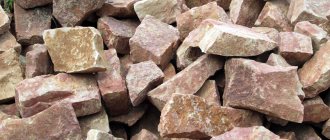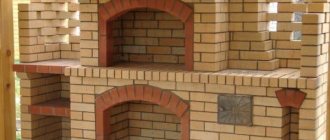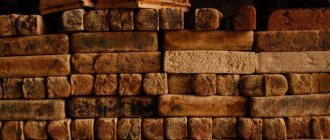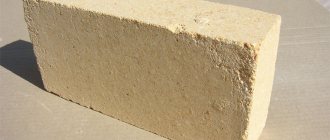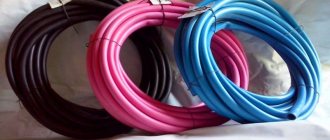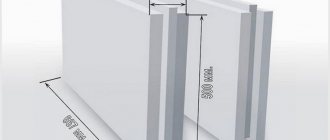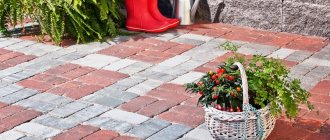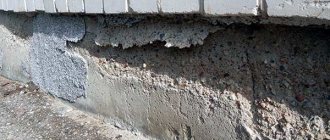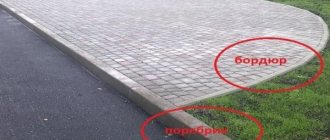The streets of modern cities and towns, major highways can no longer be imagined without such an important element as a curb stone. This is a reinforced concrete block, with the help of which the roadway and sidewalk, flower beds and pedestrian or bicycle paths are separated. Due to the wide variety of types of borders, they have become actively used for decorating various elements of landscape design in private housing construction. This element is used to decorate flower beds and flower beds, garden paths, artificial ponds in the garden plots of private houses, dachas, and country cottages.
What a curb stone is, what types it comes in, as well as what and how to make a curb with your own hands from concrete at home will be discussed in this article.
Figure 1. Curb stone
Types of curb stones
There are three main classifications of edge stone: by material of manufacture, scope of application, and by profile (cross-sectional shape).
Depending on the material of manufacture, these enclosing elements are of the following types:
- concrete, made from concrete by compacting it in special forms on vibrating tables;
- reinforced concrete with a rigid and durable internal frame made of corrugated steel reinforcement;
- granite, cut from monolithic pieces of rock.
Based on their design and dimensions, the following types of curb stones are distinguished:
- road - this type of side stone is used to delimit the roadway and sidewalk. The road curbs are gray in color and have a trapezoidal transverse profile. The dimensions of the most common standard size of this type of side stone are 1000×30×18 cm.
Figure 1. Road curb
- sidewalk - a curb with a rectangular cross-section used to separate it from the pedestrian area. A sidewalk curb also differs from a road curb in size - with a length of 100 cm, such curb stones are only 8 cm wide and no more than 20 cm high.
Figure 3. Sidewalk curb
- main - a high curb used on country roads and major highways. It has a wide base and a rounded front part.
Figure 4. Main curb
- radius - concrete side stone of a curved shape. It is used in areas where the roadway adjacent to a pedestrian zone or bicycle path has a curve.
- entrance - a curb stone with a beveled front part. It is installed in places where vehicles can drive onto the sidewalk.
Figure 5. Size and weight of the curb
The types of curb stones along the transverse profile are as follows
- BR - privates;
- BU – with expansion at the bottom;
- BUP – with an extension interrupted along the length in the lower part;
- BL – with a jelly-shaped recess (tray);
- BV – entry;
- BC – radius (curvilinear).
What are the dimensions of the curb stone?
The most applicable curb stone is 1 m long. The height and width vary depending on the location of application. To separate roads from sidewalks and lawns, a curb 30 cm wide and 15 cm high is used. At public transport stops, a curb also 30 cm wide and 18 cm high is used. Lawns are separated from pedestrian paths with a curb 20 cm wide and 8 cm high.
They also make curb stones with a length from 0.5 m to 3 m, a width from 8 cm to 20 cm and a height from 8 cm to 60 cm. Each of them has its own GOST, which describes the area of application.
Do-it-yourself curb stone installation
To independently lay edging stones on a garden or plot of land, you will need the following tools:
- container for mixing mortar or concrete mixer;
- Shovel;
- Level;
- Master OK;
- rubber mallet;
- a grinder with a diamond blade for stone or a gas cutter;
- meter building level.
Materials you will need:
- sidewalk curb;
- cement grade M400 or M500;
- sifted river sand;
- gravel with a particle size of 20-40 mm.
The process of laying a road curb with your own hands consists of the following operations:
- Marking the trench using several pegs and a clearly visible thick linen cord.
- Digging a trench - the depth of the trench should be equal to the height of the curb protrusion above the ground plus 10-15 cm for adding sand and gravel, a 1.5 cm layer of concrete
- Backfilling the sand cushion - 5-6 cm of fine river sand is poured into the bottom of the trench, moistened and compacted.
- Backfilling the gravel mixture - a layer of fine gravel 7-8 cm thick is poured onto the compacted sand cushion and also compacted thoroughly.
Important! Thorough compaction of the sand cushion and layer of fine gravel is a very responsible and important operation. If these layers are insufficiently compacted, winter heaving of the soil can lead to some curb stones beginning to change their position - rising or deviating to the side, causing destruction of the paving slabs or asphalt pavement laid inside the enclosing contour.
- Mixing the cement-sand mixture - in a large container or concrete mixer, prepare a working solution for filling the trench with a cement:sand ratio of 1:4.
- Pouring and leveling the cement-sand mixture - the finished solution is poured in portions onto the bottom of the trench, leveling using a moistened trowel.
- Installation of curb stones - install curb stones on the leveled layer of mortar, aligning them with the level of the cord by tapping with a rubber mallet.
At the final stage, the trench is filled on both sides of the installed curb stones with liquid cement-sand mortar.
Curb stone: features and advantages of use
Curb stones for sidewalks have several basic purposes:
• Discriminating function. This building material serves as an excellent separator between the roadway and the pedestrian area. So, if you want to order and buy a curb stone, then it will be an ideal way for you to separate green spaces from the pedestrian path. • Aesthetic function. In order to give the space a presentable appearance, it is worth using the method of zonal division. Quite often, the junction of the road surface and the grass surface looks sloppy precisely because of the lack of a demarcation strip between them. A border stone will allow you to maintain a certain style in the design of your summer cottage or garden area. It can be used not only to separate the road lane and pedestrian paths. Curb stone is used to decorate fountains, flower beds and other architectural structures. • Protective function. The junction of the pedestrian path with the road surface is one of the weakest points of the road surface. This part of the road is especially susceptible to early wear, which affects its appearance and failure. The curb stone is able to tightly fix the road surface and take on part of the load. Moreover, the curb stone promotes water drainage. When purchasing a curb stone, you need to look not only at how much it costs, but also at the quality of the product. The important issue here is its functionality and durability. The building material must withstand all climatic changes, and also be particularly durable and have an advantageous aesthetic component.
Types of concrete curbs
• Road curb. Durable vibro-compressed building material, which is used to improve 90% of domestic roads. When deciding to purchase a road curb, it is worth remembering that the lifespan of this material is about 20 years. This material can be used in parking areas, city roads and courtyard entrances.
• Main curb. The largest curb stone from the entire presented line . Before you order and buy a main curb, you should remember that it comes in different weights and sizes. Accordingly, the cost of the main curb will be different.
• Garden border. It is in great demand in private construction. If you want to aesthetically decorate your garden plot or a small piece of land near a private house, then a garden border is perfect for this. This version of a vibropressed garden border at a competitive price (you can find out how much a particular model costs on our company’s website) has a rougher structure. Also, if you decide to buy and order a garden border with delivery on our website, it is worth remembering that it is quite stable and durable. Its service life is more than 15 years.
Curb stone - making it yourself
The process of making edge stone consists of two main stages - preparing tools and materials, assembling the mold, and the pouring process itself.
Materials and tools
In order to make a side stone you will need the following tools:
- container for preparing concrete or concrete mixer;
- shuffle;
- galvanized 12-liter bucket;
- Master OK;
- deep vibrator (or hammer drill with mixer attachment);
- screwdriver
In order to make a high-quality road curb, you will need the following materials:
- gravel with particle size from 20 to 40 mm;
- sand;
- cement grade M400-M500;
- Chipboard 18 mm thick for making molds;
- water;
- self-tapping screws;
- plastic corner.
Making a mold for pouring - curb stone
The form for pouring these concrete products is made as follows:
- A box is made from thick chipboard - the internal length and width of the box, the height from the bottom must correspond to the same parameters of the products that are planned to be manufactured. All elements of the box are fastened with galvanized durable screws.
- Plastic corners are attached inside the box - the distance between these elements determines the width of the future product.
- Partitions are cut out of the same chipboard, which, when inserted into the mold, are fixed using corners.
Figure 6. Homemade mold for making curb stones
To prevent it from being deformed when pouring the mold with concrete, the long sides are fixed together with clamps
Making borders
Making concrete curbs on your own consists of the following steps:
- Preparation of the working solution - cement, sand and gravel are poured into a rotating bucket of a concrete mixer in a ratio of 1:3:3, water is added in such an amount that the finished solution has the consistency of thick sour cream.
- Pouring the working solution into the mold - ready-made concrete into all sections of the homemade mold using a bucket.
- Compacting concrete using an internal vibrator or a mixer attachment on a hammer drill.
- Hardening - the form with compacted concrete is pulled together on both sides using a clamp and left for 12-18 hours to harden.
- Removing the finished product from the mold - after the solution in the mold has hardened and gained the required strength, remove the clamps from the mold, turn it over and remove the finished products by lightly tapping the bottom.
Making your own curb
It happens that you are not satisfied with the expensive price, shape or length of ready-made borders, so you can make them yourself. Construction stores sell special forms for preparing curbs. To produce a homemade mold, you will need fiberboard or plywood held together with screw clamps.
It is important to prepare the concrete solution correctly . The ideal solution consists of cement, sand and gravel in a ratio of 1:1:2. When adding water, it is important to note that the solution must be dry.
If the product is large, reinforcement will be required. The solution is poured into pre-prepared molds to the very top and left for a day. After 23 hours you can already remove the formwork. The main thing in this process is accuracy so as not to damage the product. Then the curbs should dry well, then they can be installed.
Road curbs have saved people's lives more than once; in news feeds you can find many stories confirming the need to install curbs. Even modern architects have found their inspiration in these stone sculptures. In St. Petersburg they even erected a monument to the curb . The author was Vyacheslav Bukhaev. This monument has become a symbol of friendship between Moscow and St. Petersburg.
Thus, we can say that the modern world has appreciated the need for borders. Production is developing, and soon there will be no need for human labor: everything will be done by machines.
Curb stones
Curb stones are rectangular-shaped products that have a certain height in accordance with construction GOSTs. By purpose they are divided:
- Garden;
- Road;
- Curbs.
So, when laying a curb, the protruding part rises above the paving stones or asphalt, and the curb is flush with it.
The border stone is resistant to moisture and temperature changes, and is not subject to abrasion and cracking. It is also divided by height, width, weight, geometry: in the shape of a regular rectangle and with a chamfer.
What is curb stone used for?
- Curb stone is used for:
- Separation of sidewalk and roadway;
- Giving a finished look to pedestrian paths in gardens and parks;
- Design of flower beds and lawns;
- Strengthening the roadway;
- Protecting paving slabs or asphalt surfaces from dust;
- Landscape decoration.
Installation of curb stones
Before installing the curb stone, it is necessary to prepare the base. It is necessary to dig a small ditch at least 30 cm deep and fill it with sand to about 25 cm. Thus, 5 cm remain free. Next, it needs to be compacted tightly, and then covered with crushed stone in a fraction of about 40 cm and repeat the same procedure.
The next stage is the installation of the formwork into which the curb stone is installed. The second option is to place pegs by stretching a strong thread between them. This is necessary to control the correct installation of the curb. After this, a concrete mixture is poured, which holds it together and gives it a stable position.
The difference between a vibration-pressed and a vibration-cast curb
Vibration-pressed curbs are used in areas of heavy traffic or where the aesthetic appearance of the object is important. Its service life is measured in decades. The “service life” of vibrocast stone is only 3 years. Therefore, it is used either as a temporary option when repairing and equipping a facility, or where its appearance will not be of decisive importance.
What options do we offer?
- We offer 3 options for curb stones, the dimensions of which are determined according to GOST in six colors:
- Garden vibrocast 500*210*45 mm;
- Garden vibropressed 1000*200*80 mm;
- Road 1000*300*150 mm.
The price for curb stones is one of the lowest in Moscow and the Moscow region. We cooperate with both individuals and legal entities, supplying any goods in any quantities. Our specialists will help you calculate the quantity of the required product, select an assortment, and organize its delivery.
From us you can not only buy curbstones, but also order turnkey road paving services. We have been producing it in our own production using vibration pressing and vibration casting for 15 years. During this time, we have taken part in thousands of projects in Moscow and the Moscow region.
With us, you will quickly solve the problems of landscaping your local area, street, park, lawn!
Where is curb stone used?
Border stone has found wide application in urban and garden landscaping. In particular, this element is used in landscape design and construction of country and multi-storey residential buildings, in the arrangement of park areas, public gardens, outdoor sports grounds and summer cottages.
The main purpose of curbstones is to enhance the exterior. Stone is used to beautifully frame flower beds, park paths, neat lawns, etc. The construction market offers a wide selection of elements of different shapes, sizes and colors. Such a large selection allows you to choose the appropriate border to complete your tasks.
Let's highlight the main advantages of borders:
- frost resistance and resistance to moisture;
- high strength characteristics and long service life;
- attractive appearance and affordable price.
Please note that you can order the supply of any building material, be it cement-sand mixtures (cement-sand mixtures) or curb stone, on the Internet by going to the manufacturer’s website.
Road curb stones
The most common - road curb stones - have a characteristic gray color and reach a meter in length. There are, however, longer designs; They are additionally reinforced with strong steel wire during the production process. Curbs are usually installed before the road surface is laid, so that the boundaries of the future road are immediately marked. Where heavy traffic is expected (for example, on highways), the curb stone is laid on a special concrete base made of cement-sand mortar.
Making your own curbstones
If you don’t like the shape of road and garden border stones (too small, large, long, wide, etc.), you are not satisfied with the price of ready-made borders, or you simply need a border of a more complex shape, you can make it yourself.
To make formwork, it is better to use plywood or fiberboard connected using special screw clamps. In specialized stores you can also buy ready-made molds for casting curb stones. One of the most important stages in making curb stones with your own hands will be preparing the concrete solution. A concrete solution consisting of equal parts of cement and sand (400 kilograms each) and 800 kilograms of gravel is optimal for the production of borders. When adding water, make sure that the solution is a little dry. Having completed the preparation of the concrete solution, we proceed to reinforcement (if the product is large) and pouring (ready-made polyurethane molds are pre-lubricated with ordinary sunflower oil). Fill the solution to the very top and leave it in the formwork (form) for about a day. After 24 hours, the concrete, of course, will not be completely dry, but it will already gain strength, and you can safely remove the formwork. This must be done very carefully so as not to damage the product. Then the curb stones should dry for a few more days, after which they can be used. By using curb stones, you can not only separate paths, sidewalks and flower beds, making them neater and protecting them from destruction, but also give a more finished, laconic look to your garden plot, making it more harmonious and well-groomed.
